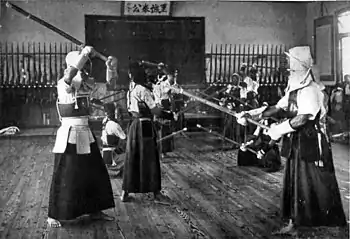Kendo Kata
Kendo Kata are fixed patterns that teach kendoka (kendo practitioners) the basic elements of swordsmanship. There are two roles, uchidachi (打太刀), the teacher, and shidachi (仕太刀), the student.[1]
.jpg.webp)
As teaching aid
Kata were originally used to preserve the techniques and history of kenjutsu for future generations.[1] In the past, many ryu or schools of kendo and kenjutsu had their own set of kata that students used to learn.[2] Kata were first unified in the Keishicho Gekken Kata or Police Department Attacking Motion Kendo Kata, when exemplary kenshi were hired to standardize kata instruction in 1880.[2] Nihon Kendo Kata were finalized in 1912 for use in public school instruction.[1][2] Modern usage of kata is as a teaching tool to learn strike techniques, attack intervals, body movement, sincerity and kigurai (pride).[1]

Nihon Kendo Kata
In kendo kata, the teacher role always moves first.[1] Both the student and teacher use bokken (木剣), except in some demonstrations which use blunted katana.[3] The first seven kata use tachi, a long bokken, for both student and teacher.[1] The last three kata use tachi for the teacher and kodachi, a shorter bokken, for the student.[1] In general, mastery of the first three kata are required for advancement to 1-Kyu and more for Dan grades.[4]
| Tachi vs. Tachi |
|---|
| Kata 1: Ippon-me |
| Kata 2: Nihon-me |
| Kata 3: Sanbon-me |
| Kata 4: Yonhon-me |
| Kata 5: Gohon-me |
| Kata 6: Roppon-me |
| Kata 7: Nanahon-me |
| Tachi vs. Kodachi |
| Kata 8: Ippon-me |
| Kata 9: Nihon-me |
| Kata 10: Sanbon-me |
Bokuto Ni Yoru Kendo Kihon-waza Keiko-ho
Bokuto Ni Yoru Kendo Kihon-waza Keiko-ho is a new form of bokken training that is directly translatable to bogu kendo.[4] Bokuto Ni Yoru Kendo Kihon-waza Keiko-ho also facilitates learning the Nihon Kendo Kata, and because of this was adopted by the All Japan Kendo Federation for use in primary and secondary school.[4] While Nihon Kendo Kata uses all five kamae, Bokuto Ni Yoru Kendo Kihon-waza Keiko-ho uses only Chūdan-no-kamae, the most common stance.[4] Instead of student and teacher roles, there are the equal roles of Motodachi and Kakarite.[4] The Motodachi receives the waza of the Kakarite.[4] The first four waza are focused on attack initiation techniques, while the final five are focused on techniques for responding to an attack.[5]
| Name and Technique | Strikes Used |
|---|---|
| Kihon 1: Ippon-uchi no waza | Men, Kote, Dō, Tsuki |
| Kihon 2: Renzoku no waza | Kote, Men |
| Kihon 3: Harai waza | Harai Men |
| Kihon 4: Hiki waza | Tsubazeriai kara no Hiki Doh |
| Kihon 5: Nuki waza | Men, Nuki Doh |
| Kihon 6: Suriage waza | Kote, Suriage Men |
| Kihon 7: Debana waza | Debana kote |
| Kihon 8: Kaeshi waza | Men, Kaeshi Migi-Doh |
| Kihon 9: Uchiotoshi waza | Doh uchiotoshi Men |
References
- "All Japan Kendo Federation: Nihon Kendo Kata". Kendo For Life, LLC. Retrieved 27 January 2015.
- Tasuke, Honda. "The History and Background of Japanese Kendo Kata". Stroud, Robert. York University. Retrieved 30 June 2015.
- "Nihon Kendo Kata". Cleveland Kendo Association. Retrieved 27 January 2015.
- Uchida, Mark (2003). "Bokuto Ni Yoru Kendo Kihon-waza Keiko-ho (Bokuto Application for Kendo Fundamental Technique Practice)". Mushinkan Dojo. Retrieved 27 January 2015.
- Quinlan, Stephen D . (May 19, 2014). "Nihon Kendo no Kata & Kihon Bokuto Waza" (PDF). Kingston Kendo Club. Retrieved 30 June 2015.